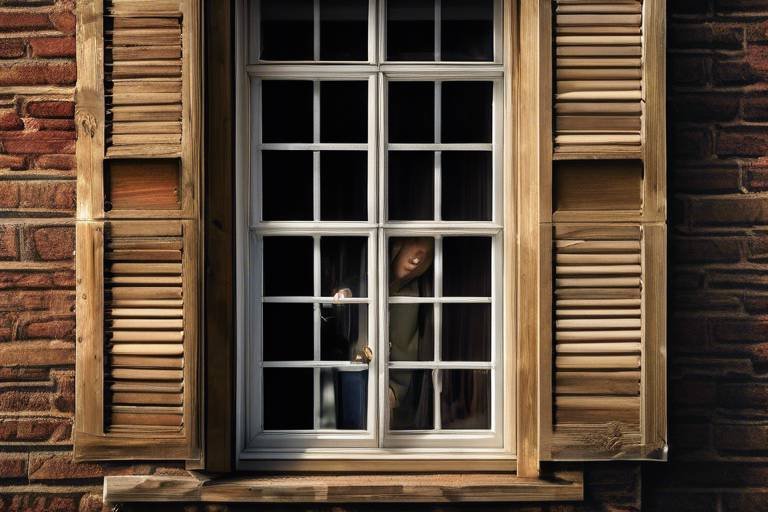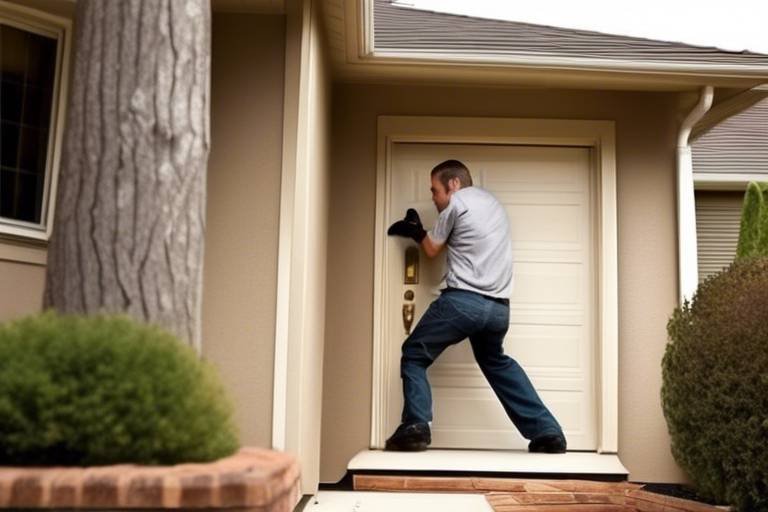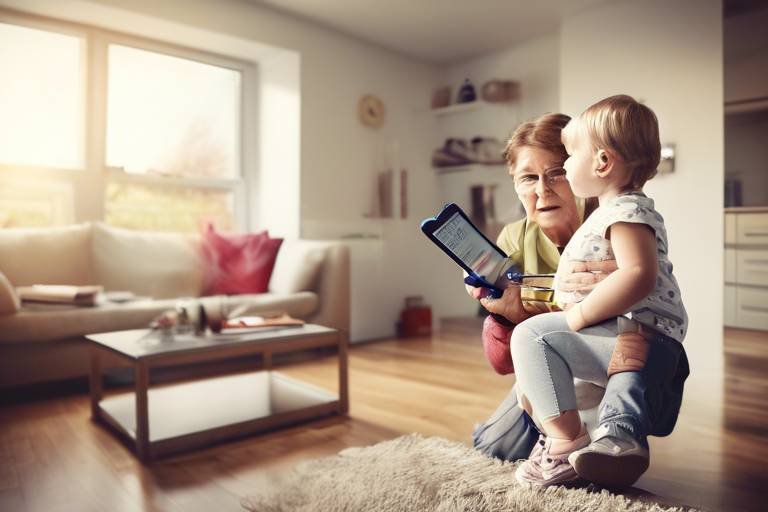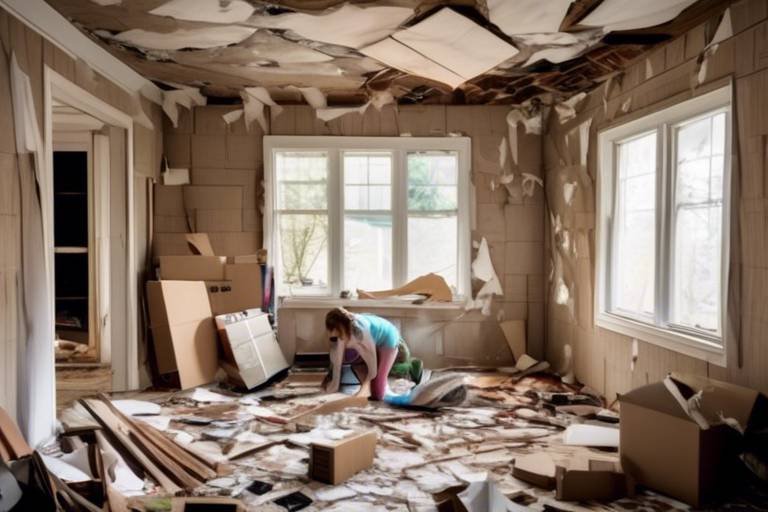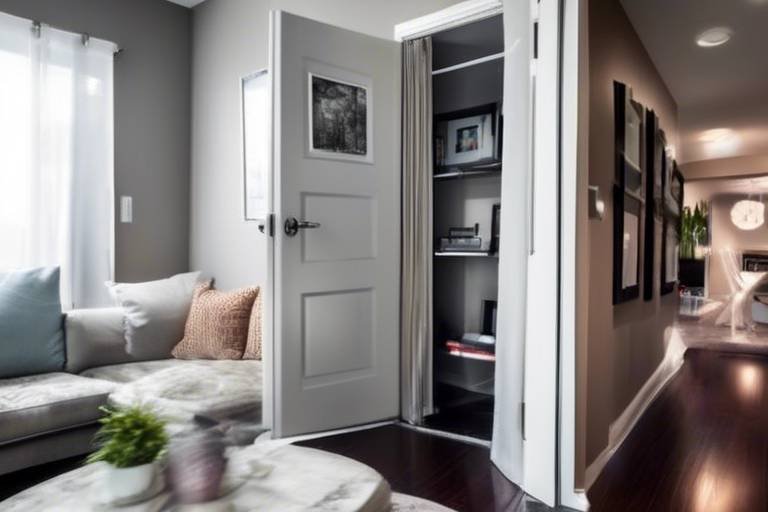Home Safety Basics – The Essentials Everyone Should Know
Home safety is not just a buzzword; it’s a way of life that ensures peace of mind for you and your loved ones. Imagine coming home after a long day, knowing that your sanctuary is secure and free from hazards. Sounds comforting, right? In this article, we’ll delve into the fundamentals of home safety, covering essential tips such as fire prevention, security measures, emergency preparedness, and childproofing. By the end of this read, you'll be equipped with the knowledge to create a safe living environment for everyone in your home.
Understanding fire safety is crucial, as it can mean the difference between life and death. Did you know that many house fires start in the kitchen? That’s why it’s vital to have smoke detectors installed in every room, especially near sleeping areas. Regularly check these devices; they should be functioning properly. Furthermore, having a fire extinguisher on hand is essential. Place it in an easily accessible location and ensure that every family member knows how to use it. But don’t stop there! Create a fire escape plan that outlines multiple exit routes and practice it with your family. This way, everyone knows what to do in case of an emergency.
Enhancing home security is not just about installing locks; it’s about creating a fortress of safety around your loved ones. Start by evaluating your surroundings. Are there dark areas outside your home? Installing outdoor lighting can significantly deter potential intruders. Additionally, consider a security system that includes cameras and alarms. These systems can provide real-time monitoring and alerts, giving you an extra layer of protection. But remember, security doesn’t just stop at your property line; being aware of your neighborhood and participating in local watch programs can foster a sense of community and safety.
When it comes to home security, entry points like doors and windows are your first line of defense. Investing in quality locks and deadbolts is non-negotiable. A flimsy lock is like a flimsy shield in battle—it won’t hold up against a determined foe. But wait, there’s more! Consider adding window security devices that prevent easy access. These small investments can make a significant difference in keeping your home safe.
Welcome to the future! Smart home devices are not just a trend; they can genuinely enhance your security. Imagine being able to lock your doors, monitor your cameras, and receive alerts, all from your smartphone. Smart locks, cameras, and alarms can be integrated seamlessly into your home. This technology allows for real-time monitoring, ensuring that you’re always in the loop, no matter where you are. It’s like having a personal security guard at your beck and call!
Building strong community ties can enhance security in ways you might not expect. Knowing your neighbors isn’t just about friendly hellos; it’s about creating a network of vigilance. Participate in local safety initiatives and neighborhood watch programs. When everyone looks out for one another, it creates a safer environment for all. Think of it as a protective web woven by the community, where everyone plays a part in keeping each other safe.
Being prepared for emergencies is essential. It’s not just about having a first-aid kit; it’s about being ready for any situation that may arise. Start by creating an emergency kit that includes essential items such as water, non-perishable food, flashlights, and batteries. But that’s not all! Develop a communication plan that outlines how your family will reach each other in case of an emergency. Understanding local emergency services and their response times can also be a lifesaver. Remember, it’s better to be over-prepared than caught off guard.
Childproofing is vital for families with young children. It’s like creating a safe haven where kids can explore without the constant worry of hazards. Start by securing hazardous areas such as kitchens and bathrooms. Store sharp objects out of reach and use safety latches on cabinets containing cleaning supplies. Establishing clear safety rules can also help prevent accidents. Remember, children are curious by nature, so creating a safe environment allows them to learn and grow without unnecessary risks.
The kitchen can be a hazardous area for children, filled with sharp knives, hot surfaces, and heavy appliances. To keep your little ones safe, store sharp objects in high cabinets or locked drawers. Secure appliances like toasters and blenders when not in use, and establish strict safety rules about what they can and cannot touch. Think of the kitchen as a bustling workshop; it’s essential to have safety measures in place to prevent accidents.
Bathrooms pose unique risks for young children, from slips to accidental drownings. To ensure a safe bathing environment, consider installing non-slip mats in the tub and on the floor. Always supervise children during bath time, and keep medications locked away and out of reach. Think of the bathroom as a mini swimming pool; without proper precautions, it can quickly become a dangerous place.
- What is the best way to test smoke detectors? Test your smoke detectors monthly by pressing the test button. Replace batteries at least once a year.
- How often should I update my emergency kit? Review your emergency kit every six months and replace expired items.
- What are some effective ways to childproof my home? Use safety latches, corner guards, and outlet covers to secure hazardous areas.

Fire Safety Measures
Understanding fire safety is crucial for every household. A fire can escalate quickly, turning from a small spark into a raging inferno in mere minutes. Therefore, implementing effective fire safety measures not only protects your home but also ensures the safety of your loved ones. One of the first steps in fire safety is the installation of smoke detectors. These devices are your first line of defense, alerting you to danger before it becomes overwhelming. It’s recommended to install smoke detectors on every level of your home, especially near sleeping areas. Don't forget to test them monthly and replace the batteries at least once a year!
Next, let’s talk about fire extinguishers. Having a fire extinguisher readily available can make a significant difference in controlling a small fire before it spreads. Place extinguishers in easily accessible locations, such as the kitchen and garage. Make sure everyone in your household knows how to use them. A simple acronym to remember is PASS: Pull the pin, Aim low, Squeeze the handle, and Sweep from side to side. This method can be a lifesaver in a critical moment.
Creating a fire escape plan is another essential component of fire safety. Sit down with your family and outline the quickest escape routes from each room in your home. Designate a safe meeting spot outside where everyone can gather after escaping. Practice this plan regularly, so it becomes second nature. Remember, in a fire situation, every second counts!
To further enhance your fire safety measures, consider the following tips:
- Keep flammable materials away from heat sources.
- Never leave cooking unattended.
- Use candles cautiously and extinguish them before leaving a room.
- Ensure that your electrical systems are up to date and not overloaded.
In addition to these practices, it's wise to understand your local emergency services. Familiarize yourself with the nearest fire department and their contact information. In case of a fire, you want to be able to call for help without delay. Keeping a list of emergency contacts, including family members and neighbors, can also provide peace of mind.
In summary, fire safety measures are not just recommendations; they are essential practices that can save lives. From installing smoke detectors and having fire extinguishers on hand to creating a well-thought-out escape plan, every step you take enhances your family's safety. Remember, being proactive is the key to preventing fires from becoming tragedies.

Home Security Tips
When it comes to keeping your home safe, enhancing your home security is not just a luxury; it’s a necessity. Think of your home as a fortress, and just like any fortress, it needs strong walls and vigilant guards. By implementing effective security strategies, you can deter potential intruders and ensure peace of mind for you and your family. One of the first steps you should consider is installing a comprehensive security system. Today’s systems are more advanced than ever, featuring motion detectors, surveillance cameras, and alarms that can be monitored from your smartphone. Imagine being able to keep an eye on your home while you’re on vacation—what a relief!
In addition to security systems, outdoor lighting plays a crucial role in deterring crime. A well-lit exterior can make a significant difference in how secure your home feels. You can install motion-activated lights around entry points and pathways. Not only do they illuminate dark corners, but they also startle any would-be intruders. Picture this: It’s a dark night, and suddenly, a light flicks on as someone approaches your door. That’s the kind of surprise you want to give to any unwelcome guests!
Another important aspect of home security is securing entry points. Doors and windows are the most common access points for intruders. Investing in high-quality locks, deadbolts, and window security devices can significantly improve your home’s safety. For instance, consider using a double-cylinder deadbolt for doors that have glass panels nearby. This type of lock requires a key on both sides, making it harder for someone to break in through the glass and reach the lock. Furthermore, don't forget about your garage; it’s often an overlooked entry point. Ensure that garage doors are secure and that any connecting doors to your home are equally fortified.
In the age of technology, why not leverage smart home devices to enhance your security? Smart locks allow you to lock and unlock your doors remotely, while smart cameras can provide real-time monitoring of your property. Imagine receiving an alert on your phone that someone is at your door, and you can check the camera feed from anywhere in the world. It’s like having a personal security guard at your fingertips! Additionally, smart home alarms can be programmed to alert you and the authorities in case of a breach. This level of integration not only keeps your home secure but also gives you the ability to respond quickly in any situation.
Home security doesn’t stop at your front door; it extends to your neighborhood. Building strong community ties can create a safer environment for everyone. Take the time to get to know your neighbors. A friendly wave can go a long way, and you might be surprised at how a sense of community can foster a watchful eye over each other’s homes. Participating in local safety initiatives, such as neighborhood watch programs, can also enhance security. These programs encourage residents to look out for one another and report suspicious activities. Just think about it: when everyone is vigilant, it’s much harder for crime to take root!
In conclusion, enhancing your home security involves a multi-faceted approach that combines technology, physical security measures, and community involvement. By taking these steps, you not only protect your home but also create a safe haven for your loved ones. Remember, safety starts at home, and every little effort counts!
- What is the best way to secure my home?
Installing a comprehensive security system, using high-quality locks, and enhancing outdoor lighting are effective measures. - How can I involve my neighbors in home security?
Get to know your neighbors and consider forming a neighborhood watch program to keep an eye on each other’s homes. - Are smart home devices worth the investment?
Yes, smart home devices provide convenience and enhanced security, allowing for real-time monitoring and alerts. - What should I do if I suspect someone is trying to break into my home?
Call the authorities immediately and do not confront the intruder yourself.

Securing Entry Points
When it comes to home safety, securing your entry points is like putting on a seatbelt before driving. It’s a simple yet effective measure that can significantly reduce the risk of intrusions. Think about it: doors and windows are the primary gateways into your home, and if they’re not properly secured, you’re essentially leaving the door wide open for unwanted visitors. So, let’s dive into some essential strategies to fortify these vulnerable spots.
First and foremost, investing in quality locks is non-negotiable. A flimsy lock is like a sign that says, “Come on in!” Opt for deadbolts, which are far more resistant to break-ins than standard locks. Additionally, you might want to consider installing smart locks. These high-tech devices allow you to control access to your home remotely, giving you peace of mind when you’re away. Imagine being able to lock your door from your smartphone while you’re on vacation – that’s the kind of security we all want!
Next, let’s talk about windows. Many homeowners underestimate the importance of window security. A locked window is only as secure as its locking mechanism. Therefore, investing in window security devices, such as pin locks or window bars, can add an extra layer of protection. Also, consider reinforcing your windows with shatter-resistant film. This not only makes the glass harder to break but also helps prevent injuries in case of an accident.
Now, while we’re on the topic of securing entry points, let’s not forget about outdoor lighting. Well-lit areas deter potential intruders more effectively than a “Beware of Dog” sign. Motion-sensor lights can be particularly effective; they illuminate dark areas as soon as someone approaches, making it difficult for intruders to go unnoticed. It’s like having a spotlight on them when they least expect it!
Lastly, a strong neighborhood watch program can be an invaluable resource for enhancing your home’s security. When neighbors look out for each other, it creates a sense of community and safety. Engaging in local safety initiatives not only fosters good relationships but also helps everyone stay informed about suspicious activities in the area. After all, a connected community is a safer community.
To summarize, securing entry points is a crucial aspect of home safety that should not be overlooked. By investing in quality locks, reinforcing windows, utilizing outdoor lighting, and fostering community ties, you can create a formidable barrier against potential threats. Remember, your home is your sanctuary, and it deserves the best protection possible. So, take these tips to heart and start fortifying your home today!
- What type of locks are best for home security?
Deadbolts and smart locks are highly recommended for their strength and technology. - How can I secure my windows?
Consider using pin locks, window bars, and shatter-resistant film for added security. - Are motion-sensor lights effective?
Yes, they can deter intruders by illuminating areas when movement is detected. - What is a neighborhood watch program?
It’s a community initiative where neighbors work together to monitor and report suspicious activities.

Smart Home Technology
In today's fast-paced world, has emerged as a game-changer, revolutionizing the way we live and enhancing our home security. Imagine being able to lock your doors, monitor your home, and even control your lights—all from the palm of your hand! With the rise of the Internet of Things (IoT), integrating smart devices into your home is not just a luxury; it's becoming a necessity for safety and convenience.
One of the most significant advantages of smart home technology is its ability to provide real-time monitoring. For instance, smart locks allow you to grant access to visitors remotely, meaning you can let in a friend while you're at work or monitor who enters your home while you're away. Additionally, smart cameras can send alerts directly to your smartphone if they detect motion, giving you peace of mind whether you’re at home or on vacation.
But it doesn't stop there! Smart home systems can also be integrated with alarms and security systems to create a comprehensive safety net for your home. Imagine receiving a notification on your phone if your smoke detector goes off, or if a window is opened unexpectedly. This level of connectivity means you can react quickly to potential threats, ensuring your family's safety at all times.
Moreover, the convenience of voice-activated assistants like Amazon Alexa or Google Assistant can enhance your home security experience. With just a simple command, you can lock the doors, turn on the lights, or even set the alarm system before heading to bed. It’s like having a personal assistant dedicated to your safety!
To give you a clearer picture of how smart home technology can enhance your security, here’s a quick comparison of some popular devices:
| Device | Functionality | Benefits |
|---|---|---|
| Smart Locks | Keyless entry, remote access | Convenience, control over access |
| Smart Cameras | Live video feed, motion detection | Real-time monitoring, alerts |
| Smart Alarms | Smoke and carbon monoxide detection | Immediate notifications, integration with other devices |
| Smart Lighting | Remote control, scheduling | Enhanced visibility, energy efficiency |
As you can see, the integration of smart devices into your home not only elevates your security but also simplifies your daily life. However, it's essential to choose devices that are compatible with each other and can be easily managed through a single app. This ensures a seamless experience and maximizes the potential of your smart home system.
In conclusion, embracing smart home technology is a proactive step towards creating a safer living environment. With the ability to monitor your home in real-time and control various aspects with ease, you can enjoy peace of mind knowing that your home is secure, whether you're there or miles away. So, why not take the plunge and upgrade your home with these innovative technologies? Your safety and convenience are worth it!
- What are the benefits of smart home technology? Smart home technology enhances security, provides convenience, and allows real-time monitoring of your home.
- Are smart home devices easy to install? Most smart home devices are designed for easy installation, often requiring little more than a Wi-Fi connection and a smartphone app.
- Can I control my smart home devices remotely? Yes, most smart home devices can be controlled remotely via smartphone apps, giving you access to your home security from anywhere.
- Is smart home technology safe from hacking? While no system is entirely immune to hacking, using strong passwords and enabling two-factor authentication can significantly enhance your security.

Neighborhood Awareness
When it comes to home safety, one of the most powerful tools you have at your disposal is your community. is not just a buzzword; it’s a vital aspect of creating a safe living environment. Think of your neighborhood as a protective shield. The stronger and more connected it is, the better it can defend against potential threats. So, how do you build this shield? It all starts with knowing your neighbors. Strike up conversations, share a cup of coffee, or even host a small gathering. These simple actions can lay the groundwork for a supportive network that looks out for one another.
In addition to fostering personal relationships, consider participating in community programs aimed at enhancing safety. For example, many neighborhoods have neighborhood watch programs that encourage residents to report suspicious activities. Getting involved in these initiatives not only helps you stay informed but also sends a clear message to would-be intruders: this community is vigilant and united. You might be surprised at how many people are willing to join forces for a common goal.
Moreover, leveraging technology can also bolster neighborhood awareness. Many neighborhoods use social media platforms or apps to share information about local events, safety tips, or even alerts about suspicious activities. Engaging in these digital discussions can keep you in the loop and allow you to contribute to the overall safety of your area. Just imagine how reassuring it is to receive real-time updates about your surroundings!
Finally, consider organizing or participating in community events that promote safety and awareness. Whether it’s a neighborhood cleanup day, a safety workshop, or a block party, these gatherings can serve as excellent opportunities to strengthen bonds and establish a culture of vigilance. When neighbors come together, they create an environment where everyone feels valued and protected. Remember, a safe neighborhood is not just about locks and alarms; it’s about the people who inhabit it and their commitment to looking out for one another.
In summary, fostering neighborhood awareness is a multifaceted approach that involves building relationships, participating in community programs, utilizing technology, and promoting collective safety initiatives. By becoming an active participant in your community, you not only enhance your own safety but also contribute to a culture of vigilance that benefits everyone. So, why wait? Start connecting with your neighbors today and watch how your community transforms into a safer haven for all!
- How can I get involved in my neighborhood watch program? - You can contact your local police department or community center to find out if there is an existing program in your area and how you can join.
- What are some effective ways to communicate with my neighbors? - Consider starting a group chat, using social media, or even creating a neighborhood newsletter to keep everyone informed.
- Are there any apps that can help with neighborhood safety? - Yes, there are various apps available, such as Nextdoor, that allow residents to share safety concerns and updates in real-time.

Emergency Preparedness
Being prepared for emergencies is not just a smart move; it’s a necessity that can make all the difference in a crisis. Imagine facing a natural disaster, a medical emergency, or even a home invasion without a plan. It can be overwhelming, right? That’s why taking the time to develop an emergency preparedness plan is essential for every household. It’s like having an insurance policy for your peace of mind.
First things first, you need to create an emergency kit. This kit is your lifeline during unexpected events. Think of it as your survival toolbox. Here’s what you should include:
- First Aid Supplies: Band-aids, antiseptic wipes, gauze, and any personal medications.
- Water: At least one gallon per person per day for three days.
- Non-perishable Food: Think canned goods, energy bars, and dried fruits.
- Flashlights and Batteries: Power outages can happen, so be ready!
- Multi-tool or Swiss Army Knife: This can come in handy for various situations.
Once you have your kit ready, the next step is to develop a communication plan. This plan should outline how your family will stay in touch during an emergency. Wouldn’t it be a relief to know that everyone knows what to do and where to go? Consider designating a meeting point outside your home and ensuring that everyone knows how to reach each other. In today’s digital age, it’s also wise to have a group chat or a messaging app that everyone can access. Just think of it as your family’s emergency hotline!
Understanding local emergency services is another critical aspect of emergency preparedness. Familiarize yourself with the emergency numbers in your area, and don’t forget to know the location of the nearest hospitals, fire stations, and police departments. This knowledge is like having a map in a foreign land; it guides you when you need it the most.
Lastly, practice makes perfect! Conduct regular drills with your family to ensure everyone knows what to do in various scenarios. Whether it’s a fire drill, a severe weather drill, or simply a plan for a power outage, these practices can help everyone react quickly and calmly when the time comes. It’s like training for a marathon; the more you practice, the better prepared you’ll be when it’s time to run!
| Emergency Scenario | Action Steps |
|---|---|
| Fire | Evacuate immediately, call 911, use a fire extinguisher if safe. |
| Earthquake | Drop, cover, and hold on until the shaking stops. |
| Flood | Move to higher ground, avoid walking through floodwaters. |
| Medical Emergency | Call 911, administer first aid if trained. |
In conclusion, emergency preparedness isn’t just about having supplies; it’s about creating a culture of safety within your home. By taking these proactive steps, you’re not just protecting your property; you’re safeguarding your loved ones. So, take a moment to gather your family, discuss your plans, and ensure that everyone is on the same page. After all, when it comes to emergencies, it’s better to be safe than sorry!
Q: What should I include in my emergency kit?
A: Your emergency kit should include first aid supplies, water, non-perishable food, flashlights, batteries, and a multi-tool.
Q: How often should I review my emergency plan?
A: It’s a good idea to review your emergency plan at least once a year or whenever there are significant changes in your household.
Q: What is the best way to communicate during an emergency?
A: Designate a meeting point and establish a group chat or messaging app to keep everyone informed.
Q: Should I practice emergency drills?
A: Yes! Regular drills help ensure everyone knows what to do and can react quickly in a real emergency.

Childproofing Your Home
Childproofing your home is not just a precaution; it's a necessity for families with young children. Imagine your home as a playground filled with both fun and hidden dangers. Every corner can hold potential hazards, and as parents, it's our job to create a safe environment where kids can explore without fear. To start, consider the various rooms in your house and the unique risks they present. From sharp objects in the kitchen to slippery surfaces in the bathroom, understanding these dangers is the first step in effective childproofing.
One of the first areas to focus on is the kitchen, often considered the heart of the home. This space can be particularly perilous for little ones. Sharp knives, hot surfaces, and heavy appliances can pose serious risks. Secure all sharp objects in high cabinets or drawers with childproof latches. Additionally, it's wise to establish clear safety rules, such as never allowing children to play near the stove or to touch hot items. You might think of your kitchen as a fortress; it needs to be well-guarded to keep your tiny explorers safe.
Next, let’s dive into bathroom safety. Bathrooms can be slippery and filled with hazardous items like medications and cleaning supplies. To prevent accidents, always keep the floor dry and use non-slip mats in the tub or shower. Installing a toilet lock can prevent curious toddlers from exploring the toilet bowl, which can be both dangerous and unsanitary. Furthermore, make it a habit to store all medications out of reach or in locked cabinets. Think of your bathroom as a sanctuary; it should be a place of relaxation, not danger.
Another essential aspect of childproofing involves securing furniture and heavy items. Many parents overlook the fact that bookshelves, dressers, and TVs can tip over, posing significant risks. To combat this, use furniture anchors to secure these items to the wall. This simple step can prevent a potential tragedy. In addition, be mindful of cords from blinds or electronics, which can be strangulation hazards. Tuck them away or use cord wraps to keep them out of reach.
Lastly, don't forget about outdoor safety. Your yard can be a fantastic place for children to play, but it can also harbor dangers like swimming pools, garden tools, and even poisonous plants. Installing a fence around a pool is crucial, and teaching your children about water safety should be a top priority. Regularly inspect your yard for any hazardous items and ensure that all tools are stored away safely. Think of your outdoor space as an adventure land; it should be thrilling but safe.
In summary, childproofing your home is a continuous process that requires vigilance and adaptability. As your child grows, new challenges will arise, and staying proactive is key. By making your home a safe haven, you can give your children the freedom to explore and learn without unnecessary risks. Remember, safety is not just about preventing accidents; it's about fostering a nurturing environment where your little ones can thrive.
- What are the most common hazards in a home for children?
Common hazards include sharp objects, hot surfaces, drowning risks in bathrooms and pools, and choking hazards from small items.
- At what age should I start childproofing my home?
It's best to start childproofing before your baby begins to crawl, as they can quickly get into things you might not anticipate.
- How often should I reassess my childproofing measures?
Reassess your childproofing measures regularly, especially as your child grows and develops new skills and interests.

Kitchen Safety Tips
The kitchen is often considered the heart of the home, but it can also be a hazardous area, especially for young children. It's essential to create a safe environment where they can explore without the constant worry of accidents. One of the first steps to ensure kitchen safety is to store sharp objects like knives and scissors out of reach. A good practice is to keep these items in a high drawer or a locked cabinet. Additionally, consider using knife blocks or magnetic strips to store knives safely while keeping them accessible for adults.
Another critical aspect of kitchen safety is the proper handling and storage of appliances. Appliances like blenders, toasters, and food processors should be kept out of reach when not in use. It's wise to unplug them after use to prevent accidental activation. Establishing clear safety rules can also help children understand the dangers associated with kitchen appliances. For instance, teaching them to never touch hot surfaces or to wait for an adult's assistance when using the stove can significantly reduce the risk of burns.
Furthermore, creating a designated cooking area can help minimize accidents. By setting boundaries, you can teach children that the kitchen is a work zone where they must be cautious. Consider using a child gate to restrict access to the kitchen when cooking or baking. This not only keeps them safe but also allows you to focus on meal prep without distractions.
Another area to focus on is the storage of hazardous materials. Cleaning supplies, detergents, and other chemicals should always be stored in locked cabinets or high shelves. Children are naturally curious, and they may not understand the dangers these substances pose. Labeling these items clearly can also serve as a reminder for adults to keep them out of reach.
To further enhance kitchen safety, consider implementing the following tips:
- Always supervise children in the kitchen.
- Use stove knob covers to prevent children from turning on burners.
- Install anti-scald devices on faucets and showerheads to prevent burns.
- Keep a fire extinguisher nearby and ensure everyone knows how to use it.
In case of an emergency, having a plan can make all the difference. Make sure everyone in the household knows how to respond in case of a fire or other kitchen-related accident. Regularly review safety procedures and practice them as a family. Remember, the goal is to create a safe, enjoyable cooking environment where everyone can participate, learn, and grow.
Q: What is the most important kitchen safety tip for families with young children?
A: The most crucial tip is to always supervise children in the kitchen and establish clear boundaries to keep them safe.
Q: How can I make my kitchen appliances safer for children?
A: Store appliances out of reach when not in use, unplug them after use, and teach children about the dangers associated with each appliance.
Q: What should I do if a child gets injured in the kitchen?
A: Remain calm, assess the injury, and provide appropriate first aid. If the injury is severe, seek medical attention immediately.
Q: How can I teach my child about kitchen safety?
A: Involve them in cooking activities, discuss safety rules, and model safe practices while preparing meals. Make it a fun and educational experience!

Bathroom Safety Precautions
Bathrooms can be a playground for little explorers, but they can also be fraught with dangers. As a parent or caregiver, it’s essential to create a safe haven for your children while they navigate this often slippery and hazardous environment. The first step in ensuring bathroom safety is to be aware of the potential risks that lurk behind every corner. From sharp objects to slippery floors, each element poses a threat that can lead to accidents if not properly managed.
One of the most significant hazards in a bathroom is the risk of slips and falls. Water can accumulate on the floor, turning it into a mini ice rink. To combat this, consider placing non-slip mats in and around the tub or shower area. These mats provide traction and can significantly reduce the chance of a child slipping. Additionally, always supervise little ones during bath time, as even a momentary distraction can lead to a dangerous situation.
Another critical area to address is the bathtub. Young children can easily slip underwater, leading to drowning incidents. To enhance safety, always keep a close eye on your child while they’re in the bath. Furthermore, it’s wise to use a bath seat or a non-slip bath mat specifically designed for children. These tools can help keep your child secure while they enjoy their bath time.
Don't forget about the importance of keeping hazardous items out of reach. Medications, cleaning supplies, and sharp objects like razors should be stored in cabinets that are either locked or high enough that children can’t reach them. You might even consider using childproof locks to keep curious hands from accessing these dangerous items. It’s remarkable how quickly children can find their way to something they shouldn’t!
Here’s a quick checklist of bathroom safety precautions:
- Install non-slip mats in the tub and on the bathroom floor.
- Always supervise children during bath time.
- Use childproof locks on cabinets containing hazardous items.
- Keep sharp objects like razors and scissors out of reach.
- Ensure that all medications are stored securely.
Lastly, consider the temperature of the water. Children have sensitive skin, and it’s easy for them to get burned by water that’s too hot. Before placing your child in the bath, always test the water temperature with your wrist or elbow. A safe temperature is usually around 100°F (37.8°C) or lower. Installing an anti-scald device on your faucet can also be a great preventive measure to keep the water temperature within a safe range.
By implementing these bathroom safety precautions, you can create a secure and inviting environment for your little ones. Remember, safety is not just about preventing accidents; it’s about fostering a sense of freedom and exploration while ensuring that your children can play and learn without unnecessary risks. After all, a safe bathroom is the first step toward a happy and healthy home!
Q: What should I do if my child slips in the bathroom?
A: If your child slips, stay calm and assess the situation. Check for any injuries and comfort them. If they are injured or unable to get up, call for help immediately.
Q: How can I make my bathroom more child-friendly?
A: To make your bathroom more child-friendly, consider using non-slip mats, installing childproof locks on cabinets, and keeping sharp objects and medications out of reach.
Q: What is the safest water temperature for my child’s bath?
A: The safest water temperature for a child's bath is around 100°F (37.8°C) or lower. Always test the water before placing your child in the tub.
Q: Should I use a bath seat for my toddler?
A: Yes, using a bath seat can provide extra support and safety for your toddler while they enjoy bath time. However, always supervise them closely.
Frequently Asked Questions
-
What are the essential fire safety measures I should implement in my home?
Fire safety starts with having smoke detectors installed on every level of your home, especially near sleeping areas. Regularly test these detectors to ensure they're working. Additionally, keep fire extinguishers accessible in key areas, such as the kitchen and garage. Finally, create and practice an escape plan with your family, so everyone knows how to exit safely in case of a fire emergency.
-
How can I enhance the security of my home?
Enhancing your home security can be achieved through various methods. Start by installing a reliable security system with cameras and alarms. Outdoor lighting is also crucial; motion-sensor lights can deter potential intruders. Don't forget to secure entry points like doors and windows with quality locks and consider joining or starting a neighborhood watch program to keep an eye on each other's homes.
-
What should I include in my emergency preparedness kit?
Your emergency preparedness kit should contain essential items like non-perishable food, water, a flashlight, batteries, a first aid kit, and any necessary medications. It's also wise to have a battery-powered or hand-crank radio to stay updated on emergency information. Don’t forget to include important documents and contact information for family members and local emergency services.
-
How do I childproof my home effectively?
Childproofing your home involves several steps. Start by securing hazardous areas, like the kitchen and bathroom, by storing sharp objects out of reach and using safety locks on cabinets. Use corner protectors on sharp furniture edges and install safety gates at stairways. Establish clear safety rules for your children and regularly assess your home for new hazards as they grow and explore.
-
What are some kitchen safety tips for families with young children?
In the kitchen, keep sharp knives and tools out of reach and use childproof locks on cabinets containing dangerous items. Always supervise your children while cooking and teach them about kitchen safety rules, such as keeping hot surfaces away from their reach. Store cleaning products and chemicals in high cabinets to prevent accidental ingestion.
-
What precautions should I take in the bathroom to ensure child safety?
Bathrooms can be particularly risky for young children. Always supervise bath time and never leave them unattended. Use non-slip mats in the tub to prevent slips and falls, and store medications and cleaning products in locked cabinets. Consider installing toilet locks to prevent drowning hazards and keep bathroom doors closed when not in use.





